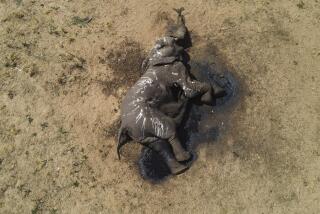New Risk Seen for Africaâs Elephant Herds
NAIROBI, Kenya â Rangers at Kenyaâs Tsavo East National Park recently stumbled upon a macabre scene: a family of 10 elephants lying in large pools of their crimson blood.
Some corpses were upturned; others were frozen on their knees as if they had died begging. Their faces were hacked away so that the poachers who killed them could extract every inch of their tusks.
A similar slaughter unfolded last month at Niassa National Park in Mozambique, where helicopter patrol pilot Phil Matthews discovered 20 slain elephants in four days. Witnessing the dead pachyderms with missing tusks, Matthews said, he was struck by a thought: âSomeone must be stockpiling ivory knowing that itâs going to be legal soon.â
Five southern African countries have been lobbying vigorously to relax the international ban on ivory sales. This weekend, wildlife authorities from 150 countries will gather in Chile to decide whether to permit those five nations to sell their stockpiles and open a permanent trade in ivory for the first time in 12 years. Many conservationists say the decision could determine the ability of Earthâs largest land mammal to survive.
Wildlife experts who support the ban point to a recent spike in poaching as an indication of what will happen if the trade is reopened. In Kenya alone, poachers have killed 70 elephants this year, compared with 54 in 2001, according to wildlife officials. Some hunters have been armed with assault weapons, and one even had a rocket-propelled grenade.
âLifting the ivory ban will be bad news for elephants,â said Paula Kahumbu, a top official with the Kenya Wildlife Service. âElephants are far from being safe, and if ivory sales are allowed, there is the possibility that elephants could be wiped out in some countries.â
The recent killings, Kahumbu and other officials say, are a reminder of the rampant poaching of the 1970s and â80s that halved Africaâs elephant population, from 1.3 million to about 625,000.
Ivory largely went out of vogue in 1990 after 150 countries belonging to the Convention on International Trade in Endangered Species effectively banned trading in elephant products.
Since then, the elephant herds in some African countries have swelled. Botswana now boasts 120,000 elephants, up from 51,000 in 1987. South Africa has about 13,000 -- nearly 5,000 more than in 1987.
In some countries, culling is necessary to keep the herds at manageable, healthy levels. Some African countries allow big-game hunters to participate but charge up to $15,000 for the experience.
South Africa, Botswana, Namibia, Zimbabwe and Zambia want the ban to be partially lifted so they can sell about 90 tons of ivory -- taken from culled elephants and those that died naturally -- to eager buyers in Japan for about $9 million. A similar, one-time sale in 1999 saw 50 tons sold to Japan for $5 million.
But perhaps more significant, those five nations also want permission to sell ivory on an ongoing basis -- a total of 13 tons a year.
South African authorities say they have virtually eradicated poaching at famed Kruger National Park. They have collected 30 tons of ivory and 152 tons of elephant hides, and money from any sale of those items would be used to buy more parkland and relocate elephants to other national parks, said Moshibudi Rampedi, director of South Africaâs Department of Tourism and Environmental Affairs.
âWeâve managed our elephants well,â she said. âWhy should we be penalized if others havenât done the same?â
But wildlife officials in India and Kenya, as well as other countries in East and West Africa, fear that if the trade reopens, poachers will target the elephant populations and stretch the already inadequate wildlife patrols.
Esmond Martin, who monitors the illegal trade in ivory for several conservation groups, said he fears that a new legal trade could stimulate demand for ivory products and drive up the price -- providing poachers with greater incentives.
âIf the price goes up, more people will go into killing elephants,â said Martin, who recently completed an extensive study on the ivory trade in Asia. âIn many of these countries, there is no alternative income. What does a Sierra Leonean or a Liberian or a Somali have for alternative employment? Almost nothing. So the price goes up, and people switch over to the ivory business.â
The illegal killing of elephants and other wildlife has other, not-so-obvious consequences, Martin said.
âPoaching encourages massive government corruption, because poachers need to bribe customs and government officials to move the ivory,â he said.
In countries such as Kenya and India, where wildlife tourism brings in hundreds of millions of dollars, poaching could have a detrimental effect on the economy by scaring away tourists. And confrontations between law enforcement officials and poachers can be deadly: In the late 1980s and early â90s, authorities killed at least 165 Zambian poachers who were hunting elephants and rhinoceroses in the Zambezi Valley.
For thousands of years, wealthy elites have prized ivoryâs white glow for figurines, furniture, sword handles and religious implements, said Martin, who has written several books and articles on ivory.
Today, demand for elephant tusks in Asia -- especially China, where signature seals and game pieces made from ivory are prized gifts -- is putting pressure on Asian and African elephant populations. Chinese authorities recently seized 3 tons of ivory that records show were shipped through Kenya. A month earlier, 6 tons of ivory from Zambia were confiscated in Singapore.
A report released early this month by the British-based network TRAFFIC, which monitors illegal wildlife trading, found that the growing economic power of consumers in China is helping drive ivory demand worldwide. The study also found that poor law enforcement in China, Thailand and some African countries was responsible for perpetuating the illegal trade in ivory.
âThe single most important factor in the illegal killing of elephants is ... unregulated domestic markets in Africa and Asia,â said Tom Milliken, an author of the report.
Indeed, the largely unregulated ivory market in Sudan supplies finished ivory figurines, jewelry and other items to the Malaysian and Chinese workers who operate oil companies in the African countryâs war-torn south.
In the Omdurman market near the Sudanese capital, Khartoum, not far from where the Blue Nile and the White Nile meet, an ivory merchant offered to sell 60 tusks -- for about $75 apiece -- to a visitor in his shop.
Most of the tusks sold in Sudan come from the regionâs conflict zones. Baggara Arab traders load camels with ivory from southern Sudan, the Central African Republic and Congo, where elephants are virtually unprotected.
Using one of the oldest trade routes in the world, they shepherd the camels hundreds of miles to southern Egypt, where the tusks are sold to Egyptian dealers and carvers. The camels are sent to the famous camel market in Cairo.
A small share of the tusks ends up in the hands of Majdi Hassan Osman, whose family has been carving and selling ivory items at an Omdurman store known simply as Gift Shop for the last quarter-century. Small animal figures are offered for about $10, Indian-style bangles for $20 and walking sticks for $200. Osman encourages haggling.
Recently, a Chinese restaurateur ordered 150 ivory chopsticks. Osman was elated.
Asked if he knew that elephants were being slaughtered for these items, Osman replied: âMost of the ivory comes from elephants who fight against each other and die.â
Conservationists say the unregulated ivory trade in Sudan and elsewhere needs to be controlled before trade is reopened. Once ivory enters the market, consumers have no way of telling the difference between legal and illegal ivory.
Conservation groups have offered to buy the ivory stockpiled by the southern African nations and destroy it. But the proposals have fallen apart over conditions sought by both sides.
In the meantime, proponents of the ban continue to press their argument that elephants are worth more alive, as tourist magnets, than dead.
âThe countries that want to sell ivory can use their elephants for far greater value,â said Kahumbu, of Kenyaâs wildlife service. âIvory is simply for the pleasure of rich people in the East. Itâs a shame that Africa is selling these animals for these people who only appreciate elephants for their teeth.â
More to Read
Sign up for Essential California
The most important California stories and recommendations in your inbox every morning.
You may occasionally receive promotional content from the Los Angeles Times.










